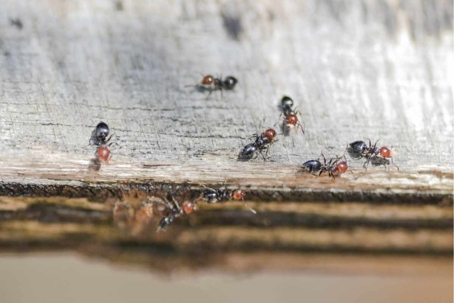Do Acrobat Ants Bite?
Acrobat ants are not typically aggressive toward humans, but these ants will bite when they feel threatened or disturbed. Biting incidents most often occur when their nests or foraging trails are accidentally disrupted. Here are the situations in which acrobat ants are most likely to bite people:
During nest disturbance: Acrobat ants often nest inside decayed wood, wall voids, or under stones and leaf litter. If you handle or move objects harboring a colony—such as firewood, tree limbs, or rotting boards—the ants may bite defensively.
When invading indoor spaces: These ants occasionally move indoors in search of moisture or food. If they establish colonies in wall voids, around plumbing leaks, or behind insulation, contact during maintenance or cleaning can trigger defensive bites.
While handling infested materials: People working outdoors—such as landscapers, gardeners, or pest control technicians—may experience bites while handling mulch, logs, or debris where acrobat ants have made nests.
During outdoor activities near nests: Acrobat ants sometimes nest under rocks, paving stones, or at the base of trees. Sitting, kneeling, or placing hands in these areas can provoke them to bite if they perceive vibration or movement as a threat.
When colonies are under stress: If a colony is sprayed with water, insecticides, or physically disturbed, the ants may become agitated and more prone to defensive behavior, leading to bites.
While acrobat ant bites are generally mild and cause only temporary pain or irritation, multiple bites can be uncomfortable.
Acrobat Ant Bites
Acrobat ant bites are generally considered mild and pose little medical risk, but they can still cause discomfort and localized irritation. The primary risks associated with their bites stem from the ants’ defensive behaviors and the body’s reaction to their bite. Here are some of the main concerns:
Pain and irritation: Acrobat ant bites can produce a sharp, pinching sensation followed by mild burning, redness, or itching. The discomfort usually subsides within a few hours.
Minor allergic reactions: Some people may experience more pronounced swelling, redness, or itching due to mild allergic sensitivity to the ant’s saliva or defensive secretions. This reaction is typically localized and not dangerous.
Secondary skin infection: Scratching the bite site can introduce bacteria into the skin, leading to redness, swelling, and infection. Keeping the area clean and avoiding scratching helps prevent this.
Chemical irritation: Acrobat ants release a foul-smelling defensive secretion containing formic acid and other compounds. In rare cases, this chemical can irritate the skin or cause a stinging sensation around the bite site.
Increased risk in sensitive individuals: People with severe insect allergies or compromised immune systems should monitor bites closely, as even minor reactions could escalate into more noticeable swelling or inflammation.
Acrobat ant bites are not medically significant compared to those of more aggressive or venomous ants (such as fire ants).
What Do Acrobat Ant Bites Look Like?
Acrobat ant bites are usually mild and can be difficult to distinguish from other minor insect bites, but they do produce some characteristic signs. Typically, an acrobat ant bite appears as a small, red bump on the skin, often accompanied by slight swelling or irritation at the site. Here’s what to look for:
Small, raised red marks: The bite area often looks like a tiny welt or pinpoint-sized bump. The redness may be localized to a small area around the bite.
Mild swelling: Some people experience light swelling around the site, particularly if the skin reacts to the ant’s bite or its chemical secretion.
Slight burning or stinging: The initial bite can cause a short, sharp pain or mild burning sensation that fades within minutes.
Itching or tenderness: As the body reacts, the bite may become itchy or slightly tender to the touch for several hours to a day afterward.
No pustules or blisters: Unlike fire ant stings, acrobat ant bites do not produce white pustules or fluid-filled blisters. The skin reaction remains superficial and limited to redness or minor irritation.
Localized reaction only: The symptoms are confined to the immediate bite area; systemic reactions are extremely rare.
In most cases, acrobat ant bites heal on their own within a day or two without leaving marks or scarring. If redness, pain, or swelling worsens after 24–48 hours, it may indicate infection or an allergic response that warrants medical attention.
What To Do About Acrobat Ant Bites
If you’re bitten by acrobat ants, the good news is that their bites are typically mild and easily managed with simple first aid. However, proper care helps prevent infection and minimizes irritation. Here’s what to do:
Move away from the source: Immediately step away from the infested area to avoid additional bites, as acrobat ants may continue to attack if they feel threatened.
Clean the bite area: Wash the affected skin thoroughly with soap and warm water. This removes any dirt, bacteria, or ant secretions and reduces the risk of infection.
Apply a cold compress: Place a cold pack or a clean cloth with ice wrapped inside on the bite for 10–15 minutes. This helps relieve pain, redness, and swelling.
Use topical treatments: Apply an over-the-counter hydrocortisone cream or calamine lotion to reduce itching and inflammation. If itching is persistent, an oral antihistamine (such as diphenhydramine or cetirizine) can help relieve discomfort.
Avoid scratching: Scratching can break the skin and introduce bacteria, leading to infection. If the area becomes itchy, apply additional cream or use a cool compress instead.
Monitor the reaction: Keep an eye on the bite over the next 24–48 hours. Mild redness and itching are normal, but you should seek medical attention if you notice spreading redness or warmth (possible infection), significant swelling, hives, or difficulty breathing (signs of an allergic reaction), or persistent pain or discharge from the bite site.
Acrobat ants often indicate moisture or decaying wood problems around homes or structures. Seal entry points, repair leaks, and contact our pest control professionals to identify and eliminate the source of the infestation.

